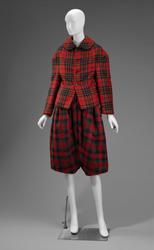Advanced Search 
In high fashion looks like this one, tartan is used to evoke a nostalgic and simplified vision of Scottish identity and culture that relies on misty moors, historical dress, and romanticized rebel histories. This vision has inspired countless designers, including Rei Kawakubo, whose plaid coat and bloomers recall 19th-century fashions.
But tartan is a complex textile with a fraught history. Originally worn as a kilt by Gaelic-speaking Scottish Highland men in the 16th century, the British monarchy violently suppressed its use in the 18th century when its Highland wearers rose up against them. The tartan kilt was later reintroduced in the early 19th century as an item of pageantry, co-opted by its British oppressors and reinvented in bright colors. Simultaneously, British colonists active in the transatlantic slave trade were known to sell tartan produced in Scotland and to clothe enslaved people in it.

Thumbnail-size images of copyrighted artworks are displayed under fair use, in accordance with guidelines recommended by the Code of Best Practices in Fair Use for the Visual Arts, published by the College Art Association in February 2015.
Tartan red plaid jacket and short padded bloomers with dropped crotch.
Designed by: Rei Kawakubo (Japanese, born in 1942)
Designed for: Comme des Garçons, Ltd. (Japanese, founded in 1969)
Designed for: Comme des Garçons, Ltd. (Japanese, founded in 1969)
Japanese
Autumn/Winter 2010–2011
Medium/Technique
Wool twill; cupra plain weave lining; polyester filling and padding
Dimensions
Center back (jacket ): 53.3 cm (21 in.)
Center back (bloomers): 69.9 cm (27 1/2 in.)
Center back (bloomers): 69.9 cm (27 1/2 in.)
Credit Line
Frank B. Bemis Fund, William E. Nickerson Fund, Otis Norcross Fund, Frederick Brown Fund, Helen and Alice Colburn Fund, and Alice M. Barlett Fund
Accession Number2017.4404.1-2
CollectionsAsia, Contemporary Art, Fashion and Textiles
ClassificationsCostumes
In high fashion looks like this one, tartan is used to evoke a nostalgic and simplified vision of Scottish identity and culture that relies on misty moors, historical dress, and romanticized rebel histories. This vision has inspired countless designers, including Rei Kawakubo, whose plaid coat and bloomers recall 19th-century fashions.
But tartan is a complex textile with a fraught history. Originally worn as a kilt by Gaelic-speaking Scottish Highland men in the 16th century, the British monarchy violently suppressed its use in the 18th century when its Highland wearers rose up against them. The tartan kilt was later reintroduced in the early 19th century as an item of pageantry, co-opted by its British oppressors and reinvented in bright colors. Simultaneously, British colonists active in the transatlantic slave trade were known to sell tartan produced in Scotland and to clothe enslaved people in it.
DescriptionRed, black and yellow plain wool jacket stuffed and padded throughout; single breasted, peter pan collar and drop shoulder. Red, black, green and blue wool twill padded boomers with dropped crotch; drawstring waist
ProvenanceBy 2017, Cynthea J. Bogel, Tieton, WA; 2017, sold by Cynthea J. Bogel to the MFA. (Accession Date: December 14, 2017)
